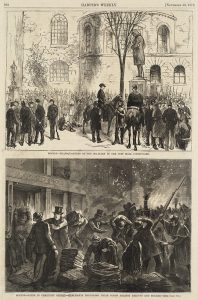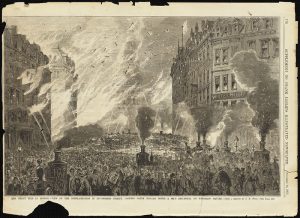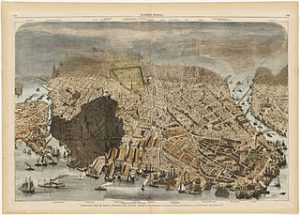On November 9, 1872, a fire broke out in Boston's commercial district. It would prove to be the most destructive fire in Boston's history. Before it was brought under control, a large part of downtown Boston would be left in ruins.
The fire started in the basement of a building on the corner of Kingston and Summer Streets at around 7:00 p.m. The alarm was raised at 7:24 p.m and by 8:00 p.m. all of Boston's twenty-one engine companies were on the scene. The fire spread quickly for a number of reasons, mainly that the wooden Mansard roofs popular in the district which provided fuel for the flame and the narrow streets enabled the fire to spread easily from building to building and street to street. The fire department struggled to fight the blaze due to inadequate water pressure from the hydrants. The low water pressure made it difficult to get water to the top floors and roofs of buildings. Plus, a flu epidemic among the department's fire horses meant that equipment had to be hand-drawn to the area. As the fire continued, the streets became jammed with spectators, looters, and merchants trying to save their property. At times, this made it difficult for the firefighters to do their jobs. Buildings were blown up in an unsuccessful attempt to create a firebreak.
In an address given to the Boston Veteran Firemen's Association, John Damrell, the city's fire engineer, described the fire: "The conflict raged for fifteen hours with an unrelenting fury" and was the "most terrific engagement by the fire department for superiority over the fire fiend ever recorded in the annals of the city." Firefighting units from the other New England states arrived to help. In fact, a Kearsarge steam engine from Portsmouth, New Hampshire was instrumental in saving the Old South Meeting House. The fire was eventually contained by midday on November 10. Before the fire was finally brought under control, Boston's commercial district, stretching from Washington Street to Boston Harbor and between Summer and Milk Streets, had been destroyed. According to the Boston Fire Historical Society the fire destroyed 776 buildings across 65 acres and caused an estimated $73.5 million (over $1.5 billion in today's dollars) in damages. The exact number of people who lost their lives was never determined but it is estimated at around thirty, including eleven firefighters.
In the aftermath of the fire, a Commission was appointed to investigate the "cause and management of the Great Fire in Boston." The immediate cause of the fire was never discovered, but the Commission compiled a detailed report that highlighted the factors that had turned the fire into a catastrophe. As many of the buildings had been heavily insured, work to rebuild the area started quickly, but changes were introduced when planning the section so that the "perfect storm" of circumstances that had produced the Great Boston Fire would never happen again. John Damrell, the chief fire engineer at the time of the fire, left the department in 1874. He founded the National Association of Fire Engineers (today's International Association of Fire Chiefs) to campaign for nationwide building safety codes. In 1877, he was appointed Boston's first building commissioner.
To access the Boston Public Library's Flickr album on the fire, click here. To learn more about the Great Boston Fire, and the history of fire and firefighting in Boston, check out the resources below:
A pictorial history of the fire.
The Boston Fire, November 9th and 10th, 1872
A detailed history of the fire, and the losses incurred, written by F. E. Frothingham in 1873.
1872; Letters Written by A Gentleman in Boston to His Friends in Paris
Letters, with an introductory chapter and notes, describing the Great Fire, written by Harold Murdock.
History of the Great Fire in Boston, November 9 and 10, 1872
Colonel Russell H. Conwell published this account of the fire in 1873.
An hour-long documentary on the life of John Damrell.
The Boston Fire Historical Society's guide to the city's fire and firefighting history.
Schorow (The Cocoanut Grove Fire) covers fire and firefighting in Boston from the seventeenth century to the present.





Add a comment to: The Great Boston Fire of 1872